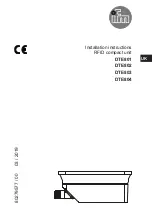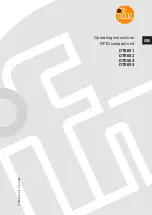
ProAct I/II
Manual 04121
36
Woodward
Menu 0—Error Menu
Menu Item
Default
Units
Active Errors
None
N/A
Logged Errors
None
N/A
Self Test Result
49*
N/A
*—The correct result is 49. Contact Woodward if the result is not 49.
Configuration, Menu 6, may be viewed at anytime. However, the engine must be
shut down and the entry code must be increased from "0" to "49" before changes
can be made to Menu 6.
To prevent possible damage to the engine resulting from improper
control settings, make sure you SAVE the set points before removing
power from the control. Failure to SAVE the set points before
removing power from the control causes them to revert to the
previously saved settings.
Description of Menu Set Points
Menu 1—Dynamics Settings
The four Gain set points and break points determine the actuator response to a
change in speed or load. These settings can vary as a percent of existing load in
nonlinear fuel systems. The adjustments are settings that affect the stability and
transient performance of the engine. A large number will provide a faster
response to an error between actual speed and reference speed. A small number
will provide a slower response to an observed error in speed.
Gain becomes an important portion of the programming that determines the
response and stability of an engine.
The control provides two sets of dynamics. Menu 1 sets the primary (normal)
dynamics. Menu 2 provides a second set of dynamics for use with an alternate
fuel or other conditions which require different control factors.
The set of dynamics being used is selected by the Alternate Dynamics contact
input (open for normal dynamics and closed for alternate dynamics).
The following descriptions apply to either set of dynamics. See Figures 4-1
through 4-4.
The four Gain and Gain Breakpoint settings in Menus 1 and 2 provide different
response scales to changes in load or speed depending on the existing actuator
position. This allows the ProAct control to be programmed to provide a response
scale that matches the engine response over the no load to full load range.
Summary of Contents for ProAct I
Page 10: ...ProAct I II Manual 04121 8 Woodward Figure 1 3 Example of ProAct II Actuator...
Page 11: ...Manual 04121 ProAct I II Woodward 9 Figure 1 4 Outline Drawing of ProAct I or II Actuator...
Page 12: ...ProAct I II Manual 04121 10 Woodward Figure 1 5 ProAct Wiring Diagram...
Page 13: ...Manual 04121 ProAct I II Woodward 11 Figure 1 6 Outline Drawing of ProAct Control Box...
Page 39: ...Manual 04121 ProAct I II Woodward 37 Figure 4 2 Typical Transient Response Curves...
















































